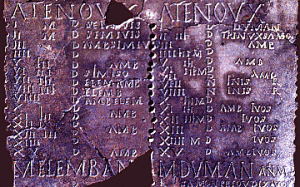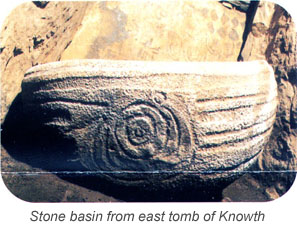Knowth
Newgrange *
Newgrange is a Neolithic monument in Ireland’s Boyne Valley, County Meath. It was constructed around 3,200 BC, which makes it older than Stonehenge and the Pyramids of Giza. Newgrange is a large circular mound 85m (279ft) in diameter and 13m (43ft) high with a 19m (63ft) stone passageway and chambers inside. The mound is ringed by 97 large kerbstones, some of which are engraved with megalithic art.
Newgrange was built by a farming community that prospered on the rich lands of the Boyne Valley. Nearby are Knowth and Dowth which are similar mounds that together with Newgrange have been designated a World Heritage Site by UNESCO(a).
 The site was fully investigated and reconstructed between 1962 and 1975. However, the reconstruction was not accepted without criticism(h).
The site was fully investigated and reconstructed between 1962 and 1975. However, the reconstruction was not accepted without criticism(h).
Both Robert Hensey(f), who has studied and written about Newgrange [1766.6] and Mike Parker Pearson, Stonehenge’s leading authority, have endorsed the idea of a French origin for megalith building(g).
Bob Quinn visited the enormous stone circle at Mzora in Morocco and was struck by its similarity to Newgrange(e)!
Newgrange is best known for the illumination of its passage and chamber by the winter solstice sun. Above the entrance to the passage at Newgrange, there is an opening called a roof-box. This baffling orifice held a great surprise for those who unearthed it. Its purpose is to allow sunlight to penetrate the chamber on the shortest days of the year, around December 21st, the winter solstice.
Like all ancient monuments, the Boyne Valley cluster has generated its collection of wild speculation, such as Freddy Silva’s claim that there is a connection between Knowth and Sacsayhuaman near Cuzco in Peru and who also hints at a possible link with Egypt’s Osirion(b)!
The unaccredited Keystone University in Ireland published a video in 2020 in which it claimed that “the neolithic tomb at Newgrange in the Boyne Valley is, in fact, the famed temple of Atlantis and one of the oldest temples on earth as a result(i).” This daft claim is a development of Ulf Erlingsson‘s theories published in 2004.
The winter solstice event is not the only astronomical link proposed for Newgrange. Anthony Murphy and Richard Moore have written(c) about the Cygnus Constellation and a possible link with Newgrange [1441]. Paul Dunbavin also touched on the possible connection between swans in Irish mythology and astronomical events(d).
Even more unlikely is the suggestion from E. A. James Swagger in The Newgrange Sirius Mystery [1683] in which the author endeavoured to link Ireland’s most important megalithic site with both an early understanding of precession and the symbology of the Dogon.
Furthermore, the imaginative Frank Joseph has speculated that “the early date for Newgrange, its circular construction, sophisticated solar orientation and mythic tradition all point to Atlantean origins.” [0636.70]
A common feature of most of the great megalithic monuments, such as Stonehenge, The Maltese Temples or Newgrange is the incorporation of astronomical alignments into their design. Recent years have seen the development of archaeoacoustics and the study of the sound characteristics of various ancient structures. Arguably the most famous site is the Hal Saflieni Hypogeum in Malta, about which Linda Eneix has written an interesting paper(j). She notes that there is a suggestion that sounds there, and possibly elsewhere, might lead to a release of the ‘feel-good’ hormone dopamine. Any inference that this was a deliberate design feature will require evidence. Eneix just touches on Newgrange acoustics that are discussed elsewhere(k).
(a) https://www.knowth.com/newgrange.htm
(c) https://www.third-millennium.co.uk/irishgodkings
(d) Mythical Ireland | Astronomy | The Cygnus Enigma (archive.org)
(e) http://heritageaction.wordpress.com/2011/01/27/the-mysterious-moroccan-megalithic-menhirs-of-mzora/ (see last comment)
(h) https://www.knowth.com/excavation.htm
(i) The Lost City of Atlantis is Ireland (irishcentral.com)
(j) https://www.academia.edu/63669239/Megaliths_Music_and_the_Mind_The_Latest_in_Archaeoacoustics
Coligny Calendar, The
The Coligny Calendar is the name given to a fragmented bronze plaque discovered in 1897 near Coligny in France. It is a calendar that has been attributed to the Celtic Sequani tribe. It is dated to the 2nd century AD, written in Roman script in Gallic and is the longest known document in that language.
Paul Dunbavin in his Atlantis of the West[099] proposed that the Coligny Calendar might be considered a lunisolar calendar. Some years later in 2005 he returned to the subject in Under Ancient Skies[101] and devoted Chapter 5 plus Appendices A & B to a discussion of Critias 119d, which relates how the kings of Atlantis met alternatively every five and six years. Dunbavin suggests that this is reflected in the Coligny  Calendar and that it possibly had antecedents that would bring its functions back to the time of Bronze Age Atlantis>(d), if not earlier(e).<Dunbavin’s reaction to the Calendar is best quoted – Now it is this passage more than any other that convinces the present author (Dunbavin) of the authenticity of the Atlantis myth“. He touches on the subject again in his latest offering, Towers of Atlantis [1627] and Prehistory Papers [1758].
Calendar and that it possibly had antecedents that would bring its functions back to the time of Bronze Age Atlantis>(d), if not earlier(e).<Dunbavin’s reaction to the Calendar is best quoted – Now it is this passage more than any other that convinces the present author (Dunbavin) of the authenticity of the Atlantis myth“. He touches on the subject again in his latest offering, Towers of Atlantis [1627] and Prehistory Papers [1758].
Alexios Pliakos, a Greek student of ancient calendars, presented a paper to the 2008 Atlantis Conference entitled A hidden Calendar in the Atlantis Story. He focused on the same Critias 119d text and like Dunbavin has independently concluded that the reference to the five and six years is strong evidence “that Atlantis did not lie in Plato’s imagination.”
There have been attempts to link the Coligny Calendar with the much earlier stone engraving found at Knowth near Newgrange in Ireland(a). An extensive and more speculative discussion of the Calendar is to be found on a New Zealand website(b). Perhaps the most exotic explanation for the source of the Calendar, questions the presumed Celtic origins and offers reasons to consider a claim that it can be traced back to ancient India(c).
>A 2020 paper by Helen Mckay entitled The Coligny Calendar: A Full Reconstruction with Modern Dates from 30 April 2020 to 4 May 2025 is freely available.(f)<
(a) https://www.sequanicalendar.com/egg.html (Link broken Nov. 2018)
See: https://web.archive.org/web/20170305004709/https://www.sequanicalendar.com/egg.html
(b) http://www.celticnz.co.nz/Coligny/ColignyPart1.htm
(c) The Coligny Five Year Yuga | MalagaBay (archive.org)
(d) e5604c_465f3f96346041fb94f8e5f960804f1f.pdf (filesusr.com) *
(e) (99+) (PDF) The Neolithic Calendar in Plato’s Critias | Paul Dunbavin – Academia.edu *
Erlingsson, Dr Ulf *
Dr Ulf Erlingsson is a Swedish geographer, geomorphologist and expert in underwater mapping. To explain several puzzles regarding the Ice Age, he developed The Captured Ice Shelf Hypothesis. He was the chairman of the Geographic Society of  Uppsala, Sweden and in 1991 he received the Linnaeus Prize from the Royal Society of Sciences in Uppsala.
Uppsala, Sweden and in 1991 he received the Linnaeus Prize from the Royal Society of Sciences in Uppsala.
Erlingsson was the American representative of AB Hydro consult(a), a spin-off from Uppsala University, Department of Physical Geography. A few years after moving to the U.S., he left AB Hydroconsult and founded Lindorm, Inc. in 2006, where he remains as CEO and President.
During the 1990s while studying the geography of the Baltic region, Erlingsson obtained a set of Soviet maps, which greatly assisted the building of the database he was engaged in. However, these maps, which had been bought openly in Riga, outlined plans for a Russian invasion of Sweden in the event of a war in Europe with NATO(b).
Since moving to Florida, Erlingsson has been very involved politically with the ‘Progressive’ wing of the Democratic Party.
Erlingsson recently identified the empire of Atlantis with the megalithic cultures of Western Europe and North Africa and suggested its capital may have been located in Ireland. His book [319] is interesting and contains a number of original ideas. However, as an Irishman, I am not convinced that our remarkable monuments in the Boyne Valley are the remains of or related to Atlantis. I will discuss this further in my review of his book. Erlingsson sees Atlantis everywhere, for example, in a carving on a stone basin found in the Knowth passage tomb close to Newgrange.
Erlingsson presented his ideas to the Atlantis Conference held on Milos in 2005(g).
Erlingsson has also suggested that the Irish authorities have deliberately made Newgrange inaccessible. This is total nonsense. As a frequent visitor to the site over many years, I have witnessed nothing but every effort being made to maximise the throughput of visitors into the very confined space within our most famous national monument. The carved basin (see image) discovered near Newgrange, is perceived by Erlingsson as a replica of Plato’s  circular city of Atlantis while I can see an early version of a Babylonian winged disk. In 2005, probably as a promotional ploy, he issued a challenge for an open debate on his theory.
circular city of Atlantis while I can see an early version of a Babylonian winged disk. In 2005, probably as a promotional ploy, he issued a challenge for an open debate on his theory.
Frank Joseph has related speculative ideas claiming that “the early date for New Grange, its circular construction, sophisticated solar orientation and mythic tradition all point to Atlantean origins.”[0636.70]
Like all ancient monuments, the Boyne Valley cluster has generated its own collection of wild speculation, such as Freddy Silva’s claim that there is a connection between Knowth and Sacsayhuaman near Cuzco in Peru and who also hints at a possible link with Egypt’s Osirion(f)!
Erlingsson has more recently suggested that the ‘sunken’ island referred to by Plato was probably located in the vicinity of the southern end of the North Sea. He proposes that around 6100 BC a tsunami generated by a massive storegga off Norway reduced the then low-lying Dogger Bank to the impassable muddy shoals recorded by Plato! He has suggested that the original Atlantis narrative, conveyed to Solon, was a mixture of an account of megalithic Ireland and a report of the inundation of Doggerland.
Dr Patrick Wallace, the Director of the National Museum of Ireland, declared that he was unaware of any archaeological evidence to support Erlingsson’s claims.
Nevertheless, Erlingsson has produced some interesting material on the bursting of glacial lakes or what is known in Iceland as jökulhlaups and their possible effect on the ending of the last Ice Age(c).
In 2020, the unaccredited Keystone University in Dublin published two articles on the Ancient Origins website, which drew on the theories of Erlingsson and supported the idea of Atlantis in Ireland(d)(e). The Keystone theory has been developed into a book[1775] by Anthony Woods.
(a) Wayback Machine (archive.org)
(b) USSR Planned to Invade Sweden (archive.org) (halfway down page)*
(c) Explanation of Bølling by jökulhlaup (archive.org)
(d) https://www.ancient-origins.net/unexplained-phenomena/atlantis-ireland-0013940
(e) https://www.ancient-origins.net/unexplained-phenomena/ireland-atlantis-0013941
